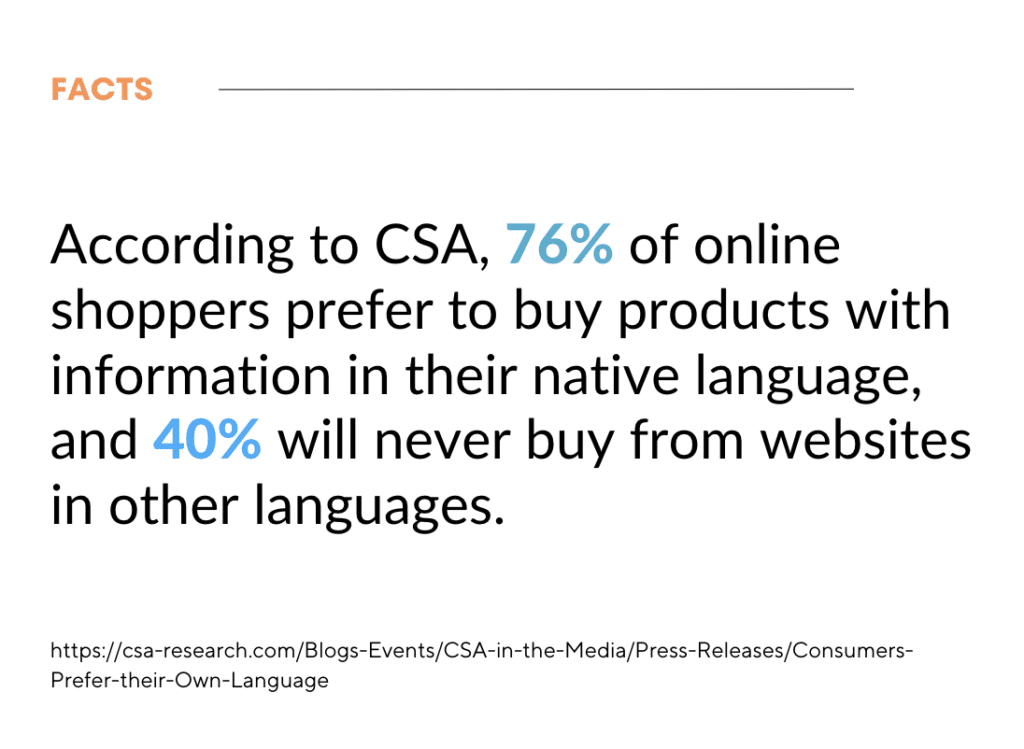As the world continues to become more connected and diverse, it is becoming increasingly important…

Tapping into Growth: Why Spanish Video Content Matters
Embracing Spanish video content is crucial for businesses and organizations to tap into the growing Spanish-speaking audience and thrive in an interconnected world, ultimately unlocking new growth opportunities in the global marketplace.
Spanish Video Content Matters
In our interconnected and culturally diverse world, businesses are faced with the imperative of reaching a broader audience. Recognizing the importance of providing video localization and transcripts in different languages is vital, with Spanish emerging as a key target. In the United States alone, there are a staggering 41 million native Spanish speakers and a growing number of Spanish-speaking households. Understanding the significance of connecting with Spanish-speaking audiences becomes paramount, especially considering that the Hispanic or Latino population accounts for approximately 19% of the total population and is projected to reach a staggering 119 million by 2060.
It is also essential to acknowledge the global prominence of the Spanish language. With over 580 million speakers worldwide, Spanish is the world’s second most commonly spoken language. This expansive and continuously growing demographic presents a pivotal opportunity for businesses and organizations to connect with a broad audience by providing translated video transcripts in Spanish.
To further emphasize the impact of Spanish-language content, let us delve into the statistics surrounding Spanish-speaking viewership in the United States. According to Nielsen, Spanish-language television networks reached an astounding 9 out of 10 Hispanic adults in the country in 2020. Furthermore, a notable increase in the share of total television viewing has been attributed to Spanish-language programming among Hispanic audiences in recent years. These figures underscore the profound influence that Spanish-language content wields within this demographic.
A report from the Pew Research Center reveals that Spanish is the second most commonly spoken language in the United States, with over 41 million native speakers. Data trends suggest that by 2050, one in three people in the U.S. will be Spanish speakers. This presents a tremendous opportunity for businesses to tap into an untapped potential audience by offering video transcripts in Spanish.
Understanding the Buying Power of Spanish-Speaking Consumers

Studies examining consumer preferences shed light on the significance of providing content in the preferred language of the target audience. For instance, the Common Sense Advisory research reveals that 72.1% of consumers spend most or all of their time on websites in their language. Furthermore, 56.2% of consumers prioritize obtaining information in their language over price considerations. These findings underscore the importance of catering to diverse language speakers, particularly within a multicultural country like the United States. By offering translated video transcripts in Spanish, businesses and organizations can effectively localize their content and reach a more extensive range of households.
The substantial buying power of Spanish-speaking consumers is another compelling reason for businesses to focus on this demographic. Projections from the Selig Center for Economic Growth indicate that Hispanic buying power in the United States is set to reach a staggering $1.9 trillion by the end of 2023, marking a significant increase from previous years. This demonstrates the immense potential for businesses and organizations that effectively cater to Spanish-speaking audiences to tap into this lucrative market.
The significance of Spanish-speaking audiences extends beyond the borders of the United States. Spanish, the second most commonly spoken language globally, with over 559 million speakers, allows businesses and organizations to reach a global audience and enhance their chances of engaging with potential customers.
Localization for Spanish-Speaking Audiences
Video localization involves adapting content to suit a specific target audience based on cultural and linguistic preferences. This process includes translating the video’s dialogue, captions, and other on-screen text into the target language and adapting any cultural references or humor to ensure they resonate with the audience.
Spanish video localization has become increasingly crucial as Spanish speakers continue to make up a significant portion of the global population. According to the Nielsen-Univision ROI of Inclusivity study, Spanish speakers in the U.S. are expected to grow to over 75 million by 2030, making up over 20% of the total U.S. population. This represents a significant opportunity for businesses and content creators looking to reach this demographic through video content.
Key Considerations for Spanish Video Content
One key consideration when localizing video content for Spanish-speaking audiences is the cultural differences between Spanish-speaking countries. For example, a successful marketing campaign in Spain may not necessarily resonate with audiences in Mexico or Colombia. Therefore, it is essential to consider these differences when localizing video content for Spanish-speaking audiences. This could involve adapting the language and tone of the video and using appropriate cultural references and humor that will resonate with the target audience.
The Nielsen-Univision ROI of Inclusivity Study also found that Spanish-speaking audiences are highly engaged with video content, with 91% of Hispanic adults in the U.S. watching online videos. This presents a significant opportunity for businesses and content creators to connect with Spanish-speaking audiences through video content. However, it also means that the competition for attention is high, and businesses need to ensure that their video content stands out from the crowd.
One way to do this is through high-quality video localization. By ensuring that the video content is culturally relevant and linguistically appropriate, businesses can increase their chances of capturing the attention of Spanish-speaking audiences. This could involve working with professional localization services specializing in Spanish video localization, ensuring that the final product is of the highest quality.
Another key consideration when localizing video content for Spanish-speaking audiences is accessibility. According to the Nielsen-Univision ROI of Inclusivity Study, over 30% of U.S. Hispanic households are Spanish dominant, meaning they primarily speak Spanish at home. Therefore, it is essential to ensure that video content is accessible to these audiences by providing Spanish subtitles.
Providing Spanish subtitles is a relatively simple way to make video content more accessible to Spanish-speaking audiences. It involves adding text to the video that displays the dialogue or narration in Spanish, making it easier for Spanish speakers to follow along. Dubbing the content in Spanish involves re-recording the audio in Spanish, replacing the original language entirely. This approach can be more time-consuming and expensive but can provide a more immersive experience for Spanish-speaking audiences.
Enhancing Engagement and Reach Through Spanish Video Localization
In addition to the benefits discussed above, Spanish video localization can improve engagement and return on investment (ROI). According to the Nielsen-Univision ROI of Inclusivity Study, Hispanic audiences are likelier to engage with video content and share it with their friends and family. Businesses and content creators who can successfully connect with this audience through video content can expect higher engagement rates and increased ROI.
Moreover, Spanish video localization can help businesses and content creators expand their reach into new markets. As the study points out, Hispanic audiences are concentrated not only in the United States but also in countries across Latin America and Europe. Businesses and content creators can tap into these markets and connect with new audiences by localizing video content for Spanish-speaking audiences.
Inclusivity, Accessibility, and SEO Advantages
Providing translated video transcripts in Spanish serves the purpose of inclusivity and accessibility. It ensures that individuals and families primarily speaking Spanish can access essential information. Furthermore, it acts as a bridge, helping to overcome the digital divide that may exist for Spanish-speaking communities with limited access to quality internet or other advanced technologies.
Notably, translating video transcripts into Spanish also confers advantages regarding search engine optimization (SEO). According to Google, 60% of consumers use search engines to initiate product and service searches. By providing translated video transcripts in Spanish, businesses and organizations can enhance their visibility and discoverability on these platforms, thereby improving their chances of reaching a broader audience.
Unlocking Growth Opportunities
In today’s interconnected and diverse world, the value of offering Spanish video transcripts cannot be overstated. By providing translated content, businesses and organizations demonstrate their commitment to inclusivity and open doors to a vast and expanding audience of Spanish speakers. With the rapid growth of Spanish speakers in the United States alone and a projected increase in the Hispanic population, catering to Spanish-speaking audiences is a strategic move that aligns with demographic trends.
The global prominence of the Spanish language, with over 580 million speakers worldwide, further reinforces the need for businesses to prioritize translated video transcripts in Spanish. By doing so, they can effectively engage with a global audience, increase brand visibility, and tap into new markets.
Embracing the preferences and needs of Spanish-speaking consumers, who prioritize accessing information in their language, proves elemental for successful business operations. The ability to provide content in Spanish not only enhances user experience but also improves customer satisfaction and loyalty. Moreover, acknowledging the significant buying power of Spanish-speaking consumers, reaching over $2 trillion in the United States alone, presents an opportunity for businesses to tap into a lucrative market and drive growth.
Furthermore, offering translated video transcripts in Spanish promotes inclusivity and accessibility. It ensures that Spanish-speaking individuals and families can access vital information, regardless of language barriers or limited technological resources. This fosters a sense of inclusiveness and bridges the digital divide, enabling a more comprehensive range of audiences to benefit from the content.
Lastly, the impact of providing Spanish video transcripts extends beyond audience reach and accessibility. It plays a pivotal role in optimizing and improving discoverability and rankings. Businesses and organizations can enhance online visibility and connect with Spanish-speaking users actively seeking relevant information by optimizing content for Spanish keywords and search queries.
Expanding Horizons: The Power of Spanish Video
Embracing translating video transcripts into Spanish represents a forward-thinking approach that caters to an intellectual and diverse audience and aligns with the demands of an interconnected world. By recognizing the significance of reaching Spanish-speaking audiences, businesses and organizations can unlock new growth opportunities, enhance their brand reputation, and ultimately thrive in an increasingly global marketplace.
Spanish video localization has become increasingly imperative as Spanish-speaking audiences grow in size and importance. By considering the cultural and linguistic differences between Spanish-speaking countries, creating high-quality, culturally relevant video content, and ensuring accessibility through Spanish subtitles or dubbing, businesses and content creators can connect with this substantial demographic to increase their chances of success. Companies that take these insights into account will be well-positioned to succeed in the years ahead.
***
Captivate Global Audiences with Advanced Video Localization Technology

Video Localization Technology: In today’s digital era, reaching global audiences is crucial for businesses and content creators. However, language barriers can hinder the effectiveness of media content in resonating with international viewers. That’s where cielo24’s advanced hybrid AI-human video localization technology bridges the gaps to offer a solution that captures global audiences while protecting your brand. Read More >>


